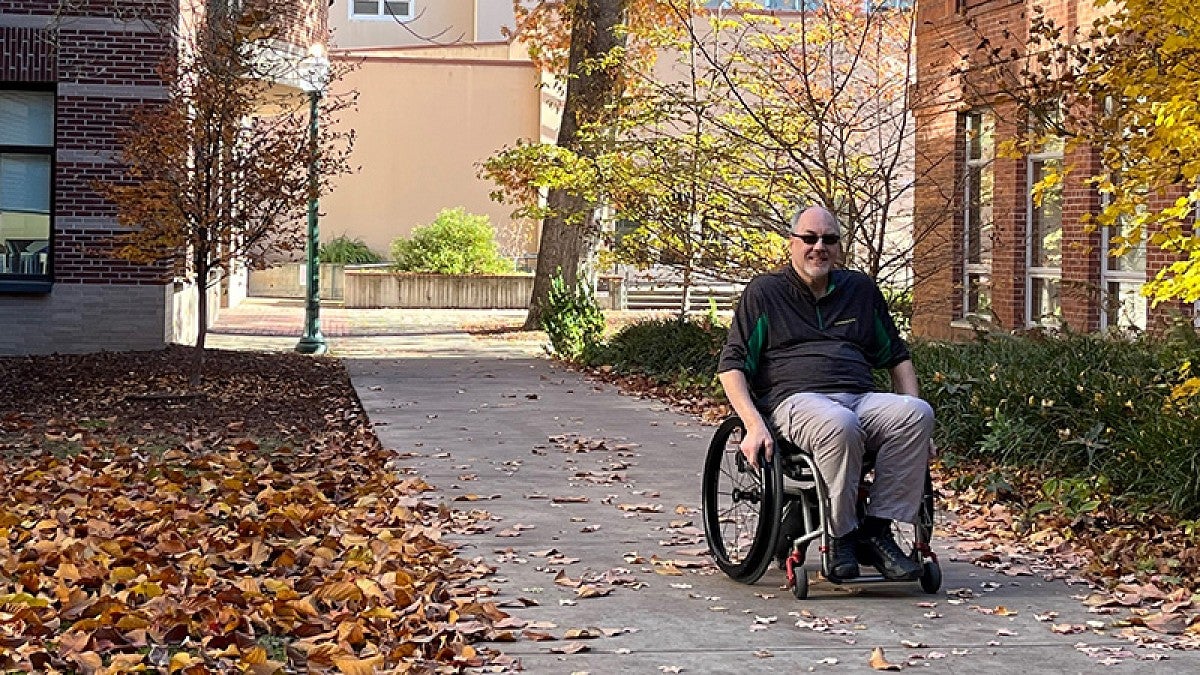When John Miller experienced a tragic spinal cord injury at age 18 and became a C5 quadriplegic, he thought one small consolation might be getting to attend college for free because of his disability.
Instead, Miller found that he had to pay his own way and “make it work, just like everybody else,” first as an undergraduate student at Simpson University in California and then when he decided to change careers and pursue a dual master’s degree in architecture and interior architecture at the University of Oregon.
That changed for Miller this year, thanks to a new partnership between the UO and the Craig H. Neilsen Foundation. The foundation offers substantial scholarships to eligible students with spinal cord injuries to lower barriers they may face to higher education.
Students with neurological and functional impairment due to traumatic spinal cord injury, degenerative disease primary to the spinal cord, or damage to the spinal cord due to tumors and surgery are eligible for support.
Neilsen scholarships cover full in-state tuition and fees and partial out-of-state tuition. They also provide supplemental support funds, if needed, to help students with books, assistive technology, transportation, child care and housing costs with up to $6,000 per academic year, and personal care assistance up to $15,000 a year.
“It’s not a little scholarship; it’s huge,” said Miller, who is 53. “It’s really an amazing opportunity for a person with a disability, most of whom won’t be coming to school from a successful career like I did.”
The Neilsen Foundation will now provide scholarships to at least two eligible UO students every year. It is assisting three UO students in the inaugural year of the partnership, including Miller.
The UO is one of just 18 institutions across the country to have been selected as a Neilsen partner for the scholarship program. The foundation connected with UO officials after learning the campus was named one of the top 20 most wheelchair-accessible college campuses in the U.S. by New Mobility Magazine.
The UO’s Accessible Education Center, a program within the Division of Undergraduate Education and Student Success, will help connect eligible students to the scholarship program and also has received a $10,000 grant from the foundation to promote accessibility at the UO.
“The Neilsen Foundation Scholarship for Spinal Cord Injury is a unique and special program that helps to reduce socioeconomic barriers for students with these injuries and thus increases their ability to pursue and fully engage in higher education,” said Norma Kehdi, senior director of the Accessible Education Center. “Having students with spinal cord injuries on the UO campus increases the diversity of thought, experience and identity of our student population, which benefits our university community as a whole.”
Miller said sprawling college campuses with many buildings often constructed before the passage of the historic Americans with Disabilities Act in 1990 are not necessarily the most welcoming spaces for people who use wheelchairs.
When he arrived at the UO, however, Miller said he felt immediately supported by the Accessible Education Center and its former senior director, Hilary Gerdes, who retired earlier this year.
“She walked the campus with me, visited all my classrooms and tried to find access solutions that would work for me,” Miller said.
“I don’t feel like you ever overcome a disability,” he added. “I mean, I’m still in a wheelchair. But I’ve integrated. The successful integrators are pretty good self-advocates and problem solvers. But, for someone to come in like (Gerdes) did and take some of that self-advocacy burden off me, I can’t express how much it matters. That experience was transformative for me.”
Miller said the motivation for his midlife change of career and return to school was that he wants to have “a more tangible impact on the lives of people with disabilities” and to help advocate for their rights in the world of construction and building design. The building access protections in the ADA for people with disabilities are often “treated as an afterthought in the real world,” he said, because “it’s hard to design to meet everybody’s needs.”
“Construction firms don’t have the time,” Miller said. “And they don’t have the money.”
The problem with that, he added, is that “it reinforces feelings that people with disabilities already often have that ‘I am not really wanted here. I don’t belong.’ I want to change that.”
Miller said the faculty at the College of Design have allowed him to pursue the area of study in the direction he wanted to go. And he’s been pleasantly surprised that there is a growing demand at architecture firms for experts on accessibility for the disabled.
Miller hopes to return to work at a local architecture firm focusing on civic and transit projects when he graduates next year. He also worked for Eugene-based PIVOT Architecture over the summer of 2022, thanks to a connection made by his UO professor for his terminal project.
“Firms are actively seeking people with disabilities; it’s the first time I’ve experienced this,” Miller said. “Connecting building designers to people with disabilities is critical because once you’ve been around somebody who has a challenge like mine, you start to think of things differently.”
As part of its new relationship with the Neilsen Foundation, the Accessible Education Center hopes to partner with Portland Community College, the foundation’s only other partner institution in Oregon, to provide a pathway to a four-year university for PCC’s Neilsen Scholars and another access point to UO for students with spinal cord injuries.
The Accessible Education Center encourages any UO students or prospective students who think they may be eligible for the Neilsen Scholarship for the 2023-24 academic year to contact them at uoaec@uoregon.edu
—By Saul Hubbard, Undergraduate Education and Student Success


